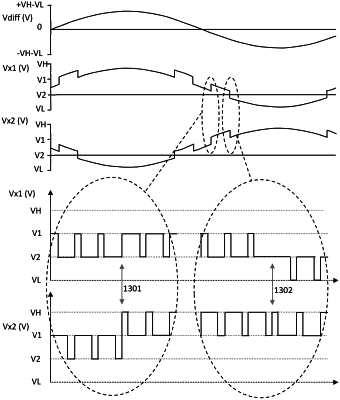| CPC B06B 1/0223 (2013.01) [B06B 1/0215 (2013.01); B06B 1/0688 (2013.01); G06F 3/016 (2013.01); H10N 30/802 (2023.02)] | 19 Claims |

|
1. A driver circuit for driving a transducer based on an input signal comprising:
first and second switching drivers with respective driver output nodes for driving said transducer in a bridge-tied-load configuration, each of the first and second switching drivers comprising a respective output stage for controllably switching the respective driver output node between high and low switching voltages with a controlled duty cycle;
wherein each of the first and second switching drivers is operable in a plurality of different driver modes, wherein the switching voltages are different in said different driver modes; and
a controller for controlling the driver mode of operation and the duty cycle of each of the first and second switching drivers based on the input signal;
wherein the controller is configured to control the duty cycles of the first and second switching drivers within defined minimum and maximum limits of duty cycles;
wherein the controller is configured to transition between different driver modes of operation when the duty cycle of at least one of the first and second switching drivers reaches the maximum or minimum duty cycle limit and the controller is configured to implement the transition by changing the driver mode of one of the first and second switching drivers at said maximum or minimum limit of duty cycle and vary the duty cycle of that one of the first and second switching drivers to the other limit of duty cycle whilst maintaining the driver mode of the other of the first and second switching drivers and applying a variation in duty cycle to maintain a magnitude of a differential component of the first and second driver signal.
|